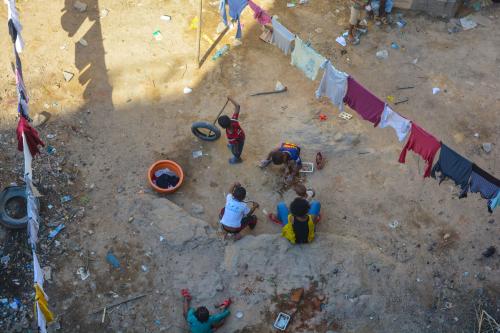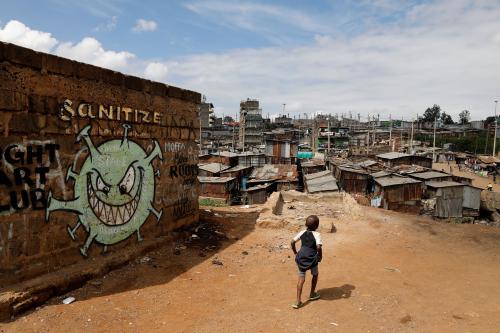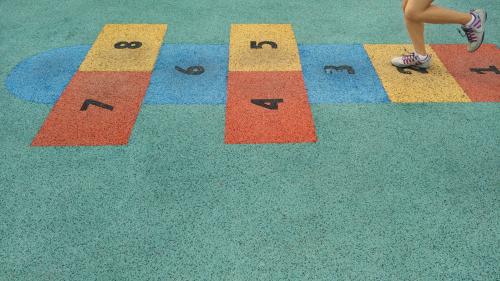In 2021, the Chinese government will do the developing world a great disservice.
It’s not what you probably think; my prediction has nothing to do with the coronavirus. It is about what the Communist Party of China (CPC) is planning to do in July. As part of the celebrations for the 100th anniversary of its founding, the CPC intends to publicize that despite the pandemic and global economic turmoil, poverty has been eradicated in China—a decade ahead of schedule.
To make this claim, the Chinese government uses a poverty line of about $2.25 a day, in 2011 prices and adjusting for purchasing power. The World Bank believes that a threshold of $1.90 a day is appropriate for countries with per capita incomes of less than $1,000 or so, such as Ethiopia. For lower-middle-income countries such as India—with per capita incomes between $1,000 and about $4,000—it recommends a poverty line of $3.20 a day. For upper-middle-income countries like China, it reckons that a reasonable poverty line is $5.50 a day. In other words, the Chinese government uses a poverty line appropriate for a country making the transition from low- to lower-middle-income, even though China is 10 times as wealthy.
Actually, China is almost as well off today as the United States was in 1960 when it became a high-income economy (using the World Bank’s classification). Around that time, the U.S. first adopted an official definition of poverty, classifying people as poor if their daily consumption was less than $21.70 in 2011 prices, four times what the World Bank today considers reasonable and about 10 times what China believes is adequate. In a forthcoming paper, my colleague Eric Dixon and I estimate that in 1960, using the $21.70 cutoff, fewer than a quarter of all Americans lived in poverty (Figure 1 is extracted from that paper). But by this criterion, between 80 and 90 percent of Chinese people would today be considered poor. If our numbers are correct, China is years—if not decades—behind schedule.
Figure 1. Headcount poverty in the US and China, 1920-2020
Percentage of population below different poverty lines
Note: Shading indicates when the per capita income was between about $4,000 and $12,500 in current dollars or approximately between $9,000 and $18,000 in 2019 purchasing power adjusted dollars.
Source: Dixon and Gill (forthcoming 2020).
Making poverty political
Last year, the World Bank warned that when the smoke from the coronavirus carnage clears, we could discover an additional 150 million people mired in poverty. Four out of every five of them will be in middle-income economies where governments have the wherewithal to prevent such setbacks.
Bucking this trend is China. A few months after the World Bank’s warning, the Communist Party of China announced that it had eradicated extreme poverty. Ending abject poverty while the rest of the world is set to see an increase in it is a remarkable achievement, and the Chinese government deserves credit. It did not happen by accident. In 2015, President Xi Jinping essentially instructed his government officials to find every poor Chinese family and end their poverty—measured using the rural poverty line of about a dollar a day (PPP unadjusted). Laudably, though, the initiative wasn’t just about this one number; the Communist Party also promised it would end the “two worries” of hunger and clothing and fulfill the “three guarantees” of health care, housing, and education.
In July 2020, the government announced that extreme poverty had been eradicated. And there is little doubt that this has happened—it is not just party propaganda. But the cost of the initiative was upwards of $800 billion. Martin Raiser, the World Bank’s man in China, says that “We’re pretty sure China’s eradication of absolute poverty in rural areas has been successful—given the resources mobilized, we are less sure it is sustainable or cost effective.”
The “eradication of absolute poverty” in China was not broadcast far and wide, but it is believed that in July, Communist Party leaders plan to remedy that. To be sure, though, the fanfare will be mainly for domestic consumption, not for export. People in poor countries are already in awe of China’s achievements since the 1980s when it began adopting U.S.-style capitalism. China has been justifiably praised for reducing poverty. The more ambitious governments in Africa and South Asia already assess their own progress in reducing poverty relative to what China has done since the 1980s (an excellent summary of China’s record since 1990 can be found here). It is the Chinese people who need convincing that the Communist Party is delivering prosperity to everyone, not just its own rank and file.
But in lowering welfare standards to puff up its own performance, the Communist Party of China will inadvertently diminish ambition everywhere. It did not cheer me up to read that U.N. Secretary-General António Guterres has been gushing about President Xi’s strategy, insisting that “targeted poverty alleviation was the only way to help the poorest people and achieve the major goals set for the U.N.’s 2030 Agenda for Sustainable Development.” I remembered Indian Prime Minister Indira Gandhi’s Garibi Hatao (“Eradicate Poverty”) slogan of 1971. It started as a clever way to win an election. But within a few years, it had morphed into the sterilization scandal, as ambitious government officials sought to remove poverty by forcibly reducing the number of babies born to poor parents. I hope China’s “precise” poverty relief initiative has a happier ending.
Because of its deliberately frugal standard, China’s poverty reduction record has become progressively diminished as it has grown richer. The accolades for the Chinese government were surely deserved in 2000 when China transitioned from low-income to lower-middle-income. The Communist Party might even have deserved praise a decade later when China became an upper-middle-income economy; reducing poverty headcounts gets harder as poverty incidence falls. But in 2021, as China approaches high income, measuring progress using the official poverty lines of the world’s poorest countries as a benchmark may be the very definition of underachievement.
World champion of poverty reduction?
The biggest decline in poverty in history—measured using a reasonable poverty line for an economy on the cusp of high income—was probably in the United States between 1930 and 1960. Using a poverty line of $21.70 a day, poverty rates fell from 78 to 23 percent (Figure 1). The main reasons:
- Economic growth fueled by New Deal projects led to job creation, the war effort created work, and the postwar global recovery led to increased demand for American products.
- America was structurally transformed as poor people—especially Southern Blacks—left the farm for jobs in cities. Between 1920 and 1960, more than 12 million Black Americans left the South for other parts of the U.S. Many others left the rural South for cities. This helped to lower poverty quickly (though not enough: the U.S. South had then and has still the greatest concentration of poor people).
- The inequality in market incomes fell, fueled both by big public investments in secondary education and the growing power of organized labor.
Tellingly, in the three decades after the Second World War, the share of the poorer half of Americans in national income rose to about 20 percent (Figure 2).
Figure 2. Sharing prosperity in the US and China, 1920-2020
Share of income held by bottom 50%
Source: Dixon and Gill (forthcoming 2020).
China will have to engineer a similar increase now. It will not be easy. China is a very different country compared with the United States in the 1950s. At the time, the U.S. had a much younger population, its workers depended a lot less on agriculture, and it was already a vibrant democracy with a growing concern for the disenfranchised. Poverty strategies in China will have to deal with the anomalies of the past, such as policies that have shrunk the number of young people and curtailed rural-urban migration. But, as the Communist Party celebrates its 100th birthday this year, its leaders might still learn a thing or two by studying what happened in the U.S. during the last 100 years.
Just as Premier Deng’s China took a page from the U.S. playbook to reintroduce market capitalism, President Xi’s party might do well to learn from the American experience with poverty reduction. Based on what I’ve learned from our recent review of upper-middle-income South Korea, Japan, and the United States, I’d recommend three things:
- Forget the flattery. The world has developed a habit of praising China for reducing poverty, and China has become accustomed to the accolades. But as China prospers, this praise becomes progressively less admiration and more flattery. The experience most relevant for China is that of the United States, especially the achievements and limits of poverty programs in Southern states. No serious Chinese student of economic history will find comparisons with the U.S. flattering.
- Forget $1.90 a day. An extreme poverty line of about two dollars a day is not interesting and relevant any longer, and repeated references to it may actually be counterproductive. It is not a relevant threshold for an upper-middle-income country about to become an advanced economy. Since the 1960s, the U.S. has been using a poverty line that is 10 times higher. China should use the Communist Party’s centenary celebrations to crank up ambition, not go on about doing what Vietnam and Taiwan had done when they were a lot poorer.
- Forget “precise relief.” Even at $15 a day, poverty incidence in the U.S., Japan, and South Korea when they made their transitions to high income was less than 10 percent; contrast this with 75 percent in China and 90 percent in rural China. If these numbers are correct, China is decades behind in poverty reduction. To catch up, it needs a radically more ambitious strategy than targeted relief.
With their backs to the wall because of COVID-19, it will be hard for China’s leaders to heed these “three forgets.” In July, expect them to loudly celebrate the “end of poverty.” But I hope they prove me wrong.









Commentary
Deep-sixing poverty in China
January 25, 2021